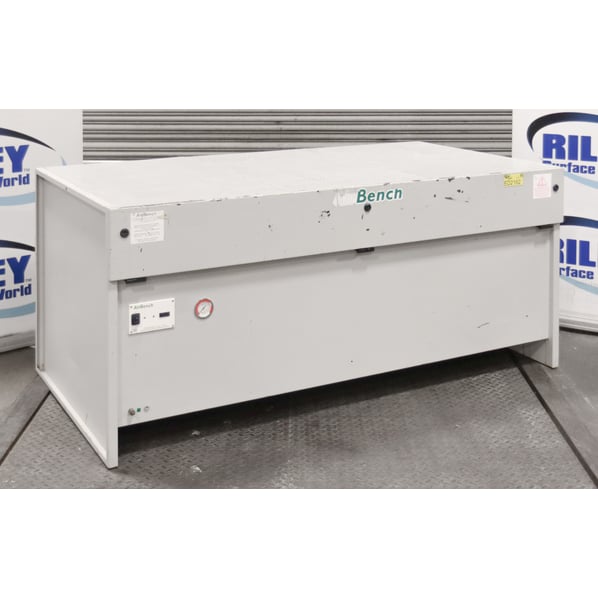Airbench FN189784 Downdraught Extraction Work Bench

- Stock No
- ED2162
- Manufacturer
- Airbench
- Model
- FN189784
- Year of Manufacture
- 2012
- Serial
- 7622/1
- Condition
- From a working environment, Good Condition
- Approx Duty CFM / M³/Hr
- 1200 // 2000
- Filter Area ft² / m²
- Various options
- Other Info
- 1800 x 900mm Working Face
- Location
- Our Central Warehouse, Aldridge, UK
- Weight (kgs)
- 125
- External Dimensions (WxDxH mm) [?]
- 1874 x 975 x 840
- Delivery Your delivery options
Description
This heavy duty AirBench FN189784 downdraught bench includes filters that are accessed via a hinged front panel for operator convenience; suitable for most applications but designed to cope with heavy industrial use.
Specification
- Fan type: Forward curved centrifugal fan
- Airflow at surface: 2000 m3/h - 1.5m/s
- Fan input: 0.59kW
- Dimensions: 1874mm x 975mm x 840 mm
- Ventilated area: 1210mm x 656 mm (TBC)
- Power supply: 240v, Single Phase
- Loading capacity: 150kg
- External finish: Two stage textured grey powder coat
- Noise level (average): 63dB
Construction
- Heavy duty 2mm steel.
- Fully welded and powder coated.
- 3mm steel surface & perforated.
- Spring clamped filters.
FN models can be supplied with a wide range of alternative filter configurations to suit different fume and dust extraction applications.
Available Filters
- ‘A’ – Non sparking dusts
- ‘H’ – Fine dusts
- ‘F’ – Fine dusts / higher volumes
- ‘B’ – Very fine dusts
- ‘L’ – HEPA filtered
- ‘E’ – Low volume fume
- ‘C’ – Light sparks
How do Dust Extractors Work?
Dust collection systems work in a variety of different ways but all have general principles in common. They draw process dust and particulates from the air through a filter that first captures and separates the matter, and then discharges decontaminated air back into the workplace or environment.
Dust extractors are used in many different and varied industries and so different demands are made of them; however all have common components such as a blower (or fan), dust filter, filter cleaning system, dust container and dust removal system.
Five common types of dust collection equipment are fabric filter baghouses, inertial separators (like mechanical cyclones), cartridge collectors, wet scrubbers, and electrostatic precipitators.
Importance of Dust Extractors
Dust in the workplace can affect product quality and employee´s health. Having a dust-free environment is essential to the health and safety of the workforce. Not only does it affect the health of employees but the dust covers the equipment affecting production processes and quality of the products.
Capturing the dust at the source prevents it from spreading, done by using a dust extractor system to facilitate the important housekeeping to avoid it from accumulating.
What is Dry Dust Extraction?
The most popular dust extraction method, dry dust extractors collect dust using filters and cartridges. Known for processing large volumes of air when filtering medium/large dust particles such as wood, flour, and metals.
They typically include a cleaning system to discharge the dust gathered within the filters and cartridges, they carry out a shaker cycle or reverse pulse cycle to free the collected dust and empty it into a removable storage bin.
![]() Print / Download Airbench FN189784 Downdraught Extraction Work Bench Datasheet
Print / Download Airbench FN189784 Downdraught Extraction Work Bench Datasheet
Photographs taken prior refurbishment. Our refurbishment service is not available on all machines.
Machines & equipment for sale
- Surface Treatment
- Cleaning & Degreasing
- Polishing & Belt Linishing
- Mass Finishing
- Ovens & Furnaces
- Process Cooling
- Shot Blasting
- Dust & Fume Extraction
- Air Compressors
- Rectifiers & Transformers
- Miscellaneous
- Latest Stock
- Special Offers
- Direct From Site Clearances
- Auctions
- Brand New Machines
- Available Immediately
- Sell Your Machine
Machine Alert
Get the latest machines emailed directly to you as they become available to buy online. Sign Up Now













